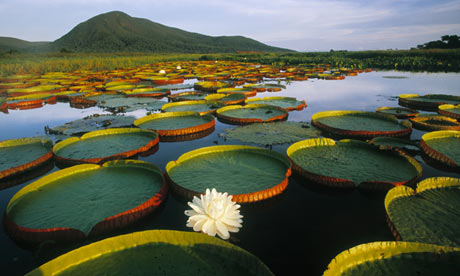The Pantanal of South America is one of the most immense, pristine and biologically rich environments on the planet. Often referred to as the world’s largest freshwater wetland system, it extends through millions of hectares of central-western Brazil, eastern Bolivia and eastern Paraguay. With its extraordinarily concentrated and diverse flora and fauna, and a landscape spanning a variety of ecological sub-regions, the Pantanal stands as one of the world’s great natural wonders.
This area is an unparalleled wildlife sanctuary of spectacular beauty, an ecological paradise containing hundreds of species of birds, thousands of varieties of butterflies, myriads of brightly colored flowers, and shoals of fish. Capuchin and Howler monkeys, capybaras, toucans, anacondas, caimans and tapirs help create an aquatic and sylvan theater of sights and sounds. The endangered jaguar, and increasingly rare Hyacinthine macaws and giant river otters, all make their home in the Pantanal. The Pantanal also provides incalculable economic benefits. It offers a huge area for water purification and groundwater discharge and recharge, climate stabilization, water supply, flood abatement, and an extensive, transport system, among numerous other important functions. And yet, despite the region’s beauty and remarkable environmental and economic value, the Pantanal remains poorly known and faces an uncertain future stemming from a myriad of socioeconomic pressures. The Florida Everglades is a stark reminder of how quickly even a major wetland system can experience devastating ecological and economic consequences when there are poor management responses to such pressures. The Everglades system declined catastrophically in just 50 years. While the Pantanal remains comparatively untouched, without correct understanding, timely action and wise management, its future could be seriously compromised.
The Brazilian government, however, is determined to attract international tourists, which is one reason why the city of Cuiabá, the northern gateway to the Pantanal, was chosen as a host city for the 2014 World Cup. It’s seen as an opportunity to promote the local wildlife to a TV audience of billions.
After a flight with stunning views over an endless expanse of greens and blues, our four-seater Cessna landed at Barra Mansa. The landing-strip was fenced off to stop the horses, wild pigs and rheas eating the grass. Guilherme Rondon, the owner, welcomed us and drove us to the lodge. The Rondons are a well-known family of Brazilian pioneers, and have been in the Pantanal since the late 19th century. Their most illustrious family member was the explorer and indigenous campaigner Cândido Rondon, who in 1913 led a scientific expedition to the Amazon with Theodore Roosevelt. “Our family has always been radically in favour of conservation,” Rondon said.
Barra Mansa is situated on a bend in the Rio Negro (not to be confused with the much larger Rio Negro that flows into the Amazon). The flood was so big that it came within a few metres of the lodge. The eyes of two submerged caimans – South American alligators – could be seen protruding above the surface at the edge of the water. On the bank was a family of capybaras, the world’s largest rodent, dog-sized and shaggy-haired, with a funny rectangular-shaped head.
I had been lured to the Pantanal on the premise of seeing a lot of wildlife, yet Rondon quickly put me right. In the dry season, he said, when the rivers shrink to a trickle, it is possible to see huge groups of animals congregating by the isolated sources of water. But since the water was unexpectedly high, many animals – tapirs, anteaters, deer, jaguars – had been pushed deeper into the bush.
But I should not be disappointed, he added, because what I had lost in fauna I had gained in flora. The floods are the most spectacular time of the year to visit. Indeed, the view from Barra Mansa was as beautiful as any that I have seen in Brazil, the shiny black water of the Rio Negro pristinely reflecting the lush vegetation surrounding it. “Visitors who see the animals always say they want to return to see the floods,” Rondon told me.
Still, there were animals to be seen – and the best way to explore was on horse. Early cattle ranchers introduced the Andalusian horse to the Pantanal, which over generations has become a new breed, the Pantanal horse, with strong feet to wade through water. They are small, docile and easy for beginners to ride.
We took a short ride through small areas of forest to reach clearings containing huge circular ponds, each about the size of a sports field. On the way we spotted an armadillo, peccaries, a tarantula, more capybaras and tall, flightless rheas.
Our guide was Luis Silva, a 51-year-old Pantanal cowboy, or pantaneiro. He stopped on the sandy path to show us all evidence of the animals that were around. There were tracks of deer, tapirs, anteaters and even the paw-print of a jaguar. The jaguar – the largest cat of the Americas – is something of a symbol of the Pantanal, although only the luckiest tourists ever spot one.
The best spotting, however, was in looking up rather than looking down – especially at the end of the day. The best vantage point to observe the birds’ passage was in a small boat in the middle of the Rio Negro. It was an unforgettable spectacle, in a beautiful setting. On our last day, we were even joined by a pair of giant otters, frolicking on the banks.
I was unlucky that there had been unexpected floods shortly before I arrived at Barra Mansa. Yet even so, I saw more wildlife in a few days in the Pantanal than I have ever seen anywhere else in Brazil.
Press Releases
 Canada Journal – News of the World Articles and videos to bring you the biggest Canadian news stories from across the country every day
Canada Journal – News of the World Articles and videos to bring you the biggest Canadian news stories from across the country every day



